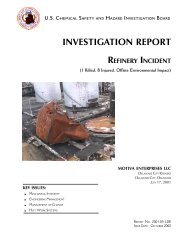CTA Report, Draft 1, ISP Review - US Chemical Safety and Hazard ...
CTA Report, Draft 1, ISP Review - US Chemical Safety and Hazard ...
CTA Report, Draft 1, ISP Review - US Chemical Safety and Hazard ...
You also want an ePaper? Increase the reach of your titles
YUMPU automatically turns print PDFs into web optimized ePapers that Google loves.
4.1.4 Molding Department<br />
After exiting the curing oven, the edges of the pad were trimmed <strong>and</strong> then the mat was cut into pieces of<br />
desired length. These pieces, called “pelts,” were manually hung on storage racks as they left the<br />
production line. Later, the pelts were moved into the molding department. There, hydraulic presses were<br />
used to fully cure the pelts <strong>and</strong> form them into their final shapes. The fully cured automotive acoustical<br />
insulation parts were then trimmed by water-jet cutters <strong>and</strong> manually packaged for shipment to <strong>CTA</strong>’s<br />
customers.<br />
4.2 Production Line Operation <strong>and</strong> Cleaning<br />
The production lines generally ran continuously during the weekdays. The day shift started at 7:00 am. A<br />
crew of five, working 12-hour shifts, normally ran each line. A crew leader directed each crew, adjusted<br />
various controls <strong>and</strong> feeder rates, <strong>and</strong> completed batch records <strong>and</strong> production logs. Other crew members<br />
typically included an inspector, an oven tender, <strong>and</strong> two blend line operators. The inspector examined the<br />
finished product as it came off the production line to determine if the product met quality specifications.<br />
The oven tender operated the curing oven <strong>and</strong> stacked pelts onto racks. Blend line operators ensured that<br />
fiberglass <strong>and</strong> resin feeders were supplied with raw materials.<br />
The crew also cleaned the lines, typically at the beginning of each shift. Daily production line cleaning<br />
usually required about 1 hour <strong>and</strong> included tasks such as:<br />
• Using compressed air to blow out the area under the forming chain in the mat-former.<br />
• Using a chimney sweep 11 or compressed air to clean the vertical pipes leading to the<br />
baghouse.<br />
11 A chimney sweep is an instrument used to clean soot or dust off surfaces inside a chimney, duct, or pipe.<br />
28









